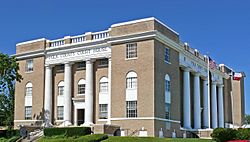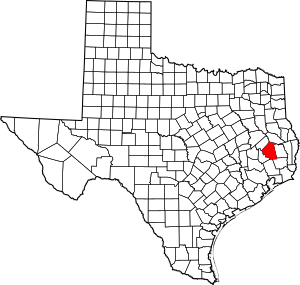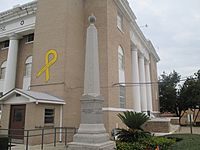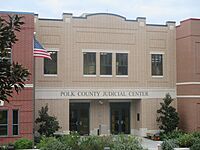Polk County, Texas facts for kids
Quick facts for kids
Polk County
|
|
|---|---|

Polk County Court House
|
|

Location within the U.S. state of Texas
|
|
 Texas's location within the U.S. |
|
| Country | |
| State | |
| Founded | March 30, 1846 |
| Named for | James K. Polk |
| Seat | Livingston |
| Largest town | Livingston |
| Area | |
| • Total | 1,110 sq mi (2,900 km2) |
| • Land | 1,057 sq mi (2,740 km2) |
| • Water | 53 sq mi (140 km2) 4.74% |
| Population
(2020)
|
|
| • Total | 50,123 |
| • Estimate
(2023)
|
50,123 |
| • Density | 45.16/sq mi (17.43/km2) |
| Time zone | UTC−6 (Central) |
| • Summer (DST) | UTC−5 (CDT) |
| ZIP Codes |
75934, 75936, 75939, 75960, 77326, 77335, 77350, 77351, 77360, 77364
|
| Area code | 936 |
| Congressional district | 8th |
Polk County is a county in the state of Texas. In 2020, about 50,123 people lived there. The main town and county seat is Livingston. The county is named after James K. Polk, who was a President of the United States.
Polk County is also home to the Alabama-Coushatta Indian Reservation. The Alabama-Coushatta people have lived in this area since the early 1800s. They are a federally recognized tribe.
Contents
History of Polk County
Polk County was created on March 30, 1846. It was named after James K. Polk, who was the 11th President of the United States. The county was formed from a part of Liberty County.
This happened after Texas joined the United States. Polk County was one of the first 23 counties created by the new Texas State Legislature.
People and Population
Polk County has grown quite a bit over the years. In 1850, only 2,348 people lived here. By 2020, the population had grown to 50,123 people.
Who Lives in Polk County?
The people living in Polk County come from many different backgrounds. Based on the 2020 census:
- Most residents, about 69.45%, are White (not Hispanic or Latino).
- About 9.71% are Black or African American (not Hispanic or Latino).
- About 1.82% are Native American (not Hispanic or Latino).
- About 0.68% are Asian (not Hispanic or Latino).
- About 3.42% are of two or more races (not Hispanic or Latino).
- About 14.65% of the population is Hispanic or Latino. This group can be of any race.
In 2000, the average household in Polk County had 2.50 people. The average family had 2.95 people. The median age for people in the county was 39 years old. This means half the people were younger than 39, and half were older.
Geography and Nature
Polk County covers a total area of about 1,110 square miles. A small part of this area, about 53 square miles, is covered by water.
Neighboring Counties
Polk County shares borders with several other counties:
- Angelina County (to the north)
- Tyler County (to the east)
- Hardin County (to the southeast)
- Liberty County (to the south)
- San Jacinto County (to the southwest)
- Trinity County (to the northwest)
Protected Natural Areas
Part of the Big Thicket National Preserve is located in Polk County. This preserve protects a unique natural area with many different plants and animals.
Education in Polk County
Polk County has several school districts that serve its students:
- Big Sandy Independent School District
- Chester Independent School District
- Corrigan-Camden Independent School District
- Goodrich Independent School District
- Leggett Independent School District
- Livingston Independent School District
- Onalaska Independent School District
- Woodville Independent School District
For higher education, the county is part of the Angelina College district. In 2013, the Polk County College / Commerce Center was built. This center offers college-level courses and technical training. It also has a large public space that can be used for community events or as a shelter during emergencies.
Important Buildings and Services
The Texas Department of Criminal Justice operates the Allan B. Polunsky Unit in West Livingston. This is a large correctional facility.
Getting Around Polk County
Main Roads
Several important highways run through Polk County:
 U.S. Highway 59 (which is becoming
U.S. Highway 59 (which is becoming  Interstate 69)
Interstate 69) U.S. Highway 190
U.S. Highway 190 U.S. Highway 287
U.S. Highway 287 State Highway 146
State Highway 146
There are also several Farm to Market Roads, which are smaller state highways:
 Farm to Market Road 350
Farm to Market Road 350 Farm to Market Road 356
Farm to Market Road 356 Farm to Market Road 357
Farm to Market Road 357 Farm to Market Road 942
Farm to Market Road 942 Farm to Market Road 943
Farm to Market Road 943 Farm to Market Road 1745
Farm to Market Road 1745
Public Transport
Greyhound Lines offers bus services from the Livingston Station. It is located at the Super Stop Food Mart in Livingston.
Airport
The Livingston Municipal Airport is in West Livingston. It is managed by the City of Livingston.
Towns and Communities
Polk County has several towns and communities:
Cities
Towns
- Corrigan
- Livingston (This is the county seat, the main town for county government.)
Census-Designated Places
These are areas identified by the census bureau for statistical purposes:
- Big Thicket Lake Estates (partly in Liberty County)
- Cedar Point
- Indian Springs
- Pleasant Hill
- West Livingston
Unincorporated Communities
These are smaller communities that are not officially part of a city or town:
Former Town
- Laurelia (This is a ghost town, meaning it's no longer inhabited.)
Famous People from Polk County
Many notable people have connections to Polk County:
- Percy Foreman – A well-known lawyer who defended people in criminal cases.
- John Wesley Hardin – A famous figure from the Old West.
- William P. Hobby – A former Governor of Texas and a newspaper publisher.
- Sam Houston – A general and President of the Republic of Texas. He spent time in Polk County and made peace treaties with the Alabama-Coushatta people.
- Margo Jones – A stage director who helped start the careers of famous actors and playwrights.
- René-Robert Cavelier, Sieur de La Salle – A French explorer from the 1600s. It is believed he was killed in Polk County.
- Sally Mayes – A Broadway actress and singer. A street in Livingston is named after her.
- Mark Moseley – A professional football player who won the Super Bowl XVII.
- Moon Mullican – A musician known as the "King of the Hillbilly Piano Players."
- Captain Isaac Newton Moreland Turner – A Confederate captain during the Civil War. His remains were brought back to Polk County in 1995.
- Annette Gordon-Reed – A historian and law professor born in Livingston. She won a Pulitzer Prize for her work on Thomas Jefferson.
See also
 In Spanish: Condado de Polk (Texas) para niños
In Spanish: Condado de Polk (Texas) para niños



